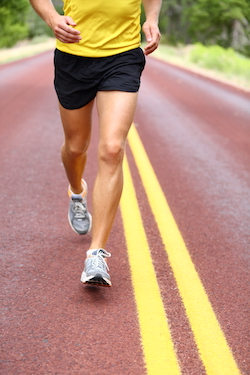Dr. Kenneth Swan Featured In Asbury Park Press “Taking care of your knees”

Dr. Kenneth Swan was featured in an article today in the Asbury Park Press where he talks about how runners can protect their knees. Beyond his expertise in sports, Dr. Swan was a 3-sport athlete in high school and played college football, giving him unique insights into knee health with regular heightened demand on the joints.
Taking Care of Your Knees
Gloria Averbuch
 A staggering 100,000 knee joints endured the impact of 26.2 miles in the New York City Marathon on Nov. 2. That’s a lot of punishment for the most commonly injured joint in the body.
A staggering 100,000 knee joints endured the impact of 26.2 miles in the New York City Marathon on Nov. 2. That’s a lot of punishment for the most commonly injured joint in the body.
Yet our knees, in concert with the bones, cartilage, muscles, ligaments and tendons, provide the stability and flexibility to perform amazing tasks, such as carrying our bodies over the marathon distance. Of all the joints, knees bear the brunt of the effort in a sport like running.
Dr. Kenneth Swan knows knees — both as an orthopedist and a runner. Dr. Swan is a member of University Orthopaedic Associates (UOA), New Jersey’s largest orthopedic practice, and an Assistant Clinical Professor at Rutgers Medical School. He sees patients in UOA’s Wall office.
“The knee is an amazing joint and built to withstand a lot. It is built to walk and I believe to run, for some distance. It is a beautiful joint but factors come into play that make it susceptible to damage,” he says. These factors include running surface, shoes, body weight, alignment, and genetic make-up. Also key to the knee’s endurance is the strength and conditioning of the muscles surrounding the joint.
Dr. Swan, a three-sport athlete in high school and college football player, began running as a stress release during his medical studies. He currently competes in trail runs.
“I think its great there are so many runners. I do see a lot of them, both genders and all ages. There are a number of races, including marathons, in the fall so I see a fair share of injuries this time of year. In terms of joints, a lot of the injuries are to the knees, followed by ankles and hips.”
There’s good reason why running puts us at risk. Explains Swan, “We classify activities as either high or low impact in terms of potential damage or stress on a joint. Long distance running, together with such sports as basketball and volleyball, is high impact.” That means that up to four times our body weight goes through the knee with every footfall.
“Conflicting studies show the jury is still out as to whether running is good or bad for the joints. It is not exclusively or necessarily bad for joints. I don’t tell patients not to run if that’s what they love to do because I think it’s healthier for them to participate in a good activity than to worry it is bad for the joints, because I don’t think that’s proven,” Dr. Swan said.
Here are a few tips Dr. Swan gives runners to protect their joints:
- Running surface matters. Swan gives an example that is close to home: “My wife runs back and forth from laps at a high school track, so that half of her run is on a forgiving, spongy surface.”
- Don’t run on “old tread.” Running shoes should be replaced when they have lost cushioning and support. The general recommendation is anywhere from 300 to 500 miles, or a couple of times a year.
- Mix it up. “I’m a firm believer in cross training,” says Swan, which means doing a variety of activities. He tells runners that cross training takes some stress off the joints and provides a more balanced program.
- Pay attention to what you put into your body. Eat a healthy and balanced diet. As a doctor with a background in nutrition and supplements, Swan also points out that although there are mixed studies on many supplements, there are two especially worth considering: glucosamine and chondroitin. These are claimed not only to decrease inflammation and pain, but also to build new cartilage. Dr. Swan believes that, “although these two are not a magic bullet, it is worthwhile to try them for knee problems.”
When is it time to see a doctor? Says Swan, “It’s good to listen to your body. For most orthopedic conditions, if you are in pain from something that arises without obvious trauma, rest the area. Take a simple over-the-counter medication as needed. If after two weeks it doesn’t resolve, and/or you’re having trouble bearing weight, that would tell me it’s time for you to see a physician.”
“I tell people there is probably a limit to what the body can withstand, so if they are training for a marathon and something pops up, not to get depressed. It’s to be expected. Take a break and get back to health.”
The bottom line, according to Swan: “Exercise helps our overall health and helps relieve stress. We have an overweight and overstressed society. If it can help with those things, I think running is a small price to pay regarding the risk to joints. I think people should run and enjoy it in a balanced, smart way, without overdoing it.”
Gloria Averbuch is a past New Jersey 10-mile Masters running champion and author of numerous running books.
Strength Training for Joint Protection
Studies have repeatedly shown that strength training not only helps prevent injury in runners and other athletes, but assists in improved performance. Blake Swan (no relation to Dr. Kenneth Swan) is Director of Sports Performance and Wellness for University Orthopaedic Associates. He advises runners to train like the pros. “Most college or professional runners have an element of strength training in their programs,” Swan says.
He suggests long distance runners should minimally be strengthening using their own body weight. This helps protect the lower body joints that incur the impact of the activity. You can start with: single leg Romanian deadlifts (for hamstring: back of thighs); squats/lunges (for quads: front of thighs), and step-ups (add a toe lift to the step-up phase to work your calves). Do two sets of about 20 reps 3-5 times a week, if possible.
You can eventually graduate to adding hand weights to the routine, such as 5-pound weights to start. Swan advises adding upper body strengthening to the mix by incorporating the running motion with your arms with those hand weights while doing the above routine.
Concludes Swan, “Above all, make sure you practice good technique. That’s true for running as well as strength training. Like running, good mechanics in strength training keep you from compromising technique due to fatigue, which is when people often get injured.”

